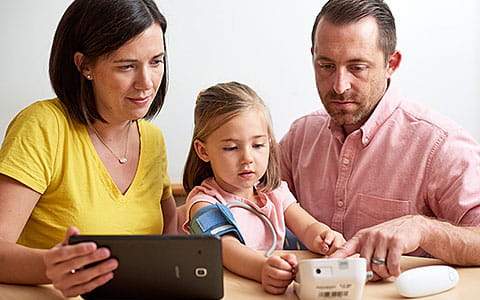Improving Care for Patients Outside the Hospital

Cincinnati Children’s launched its Remote Patient Monitoring (RPM) program in February 2017 with the mission to improve the outcomes and experience for patients with high-risk and chronic conditions outside the hospital walls.
Patients and families self-report health information to their care team through an application (app) on their smartphone or tablet. Vital stats including blood pressure, weight, temperature, oxygen levels and pulse are collected via Bluetooth-enabled devices and transmitted to the app.
Condition-specific questionnaires are sent in the app on a scheduled basis to get feedback on the patient’s current health status. The responses and vital stats are reviewed by a team of registered nurses who partner with subspecialist providers to address any concerns. This helps to identify concerns sooner, helping to keep the patient at home and out of the hospital. The RPM nurses are available by text and video call through the RPM app on-demand to provide reassurance and care to patients and caregivers when they need it most.
Remote Patient Monitoring currently has programs in the following areas:
- Cardiology
- Adult congenital heart disease high risk for heart failure
- Cardiomyopathy
- Cardiac tube weaning
- Heart transplant
- Ventricular assist device (VAD)
- Complex Care
- Failure to thrive
- Genetics
- Cleft infants
- General Pediatrics / Foster Care Clinic
- Asthma
- Failure to thrive
- Gastroenterology
- Failure to thrive
- Interdisciplinary feeding team
- Short gut Non-TPN
- Short gut TPN dependent
- Neonatology
- Feeding tube dependent
- Concern for inadequate weight gain
- High calorie formula dependent
- Oxygen dependent
- Nephrology
- Peritoneal dialysis
- Pain
- Post operation knee / shoulder repair with nerve catheter
- Post operation pectus excavatum repair
- Solid Organ Transplant
The benefits of RPM include:
- Increased ability for family to remain at home for things that previously required in-person visits such as weight checks
- Increased family engagement in plan of care, and better adherence to treatment plans (for example, taking medications as directed)
- Confidence for families learning new care for conditions, knowing the care they provide at home will be supported by a team of specialty trained nurses
- Reduced need for emergency room visits and inpatient stays by allowing connection to care team from home and from identification of clinical changes early




